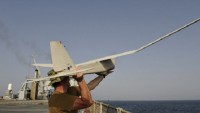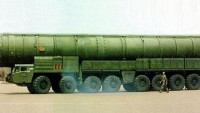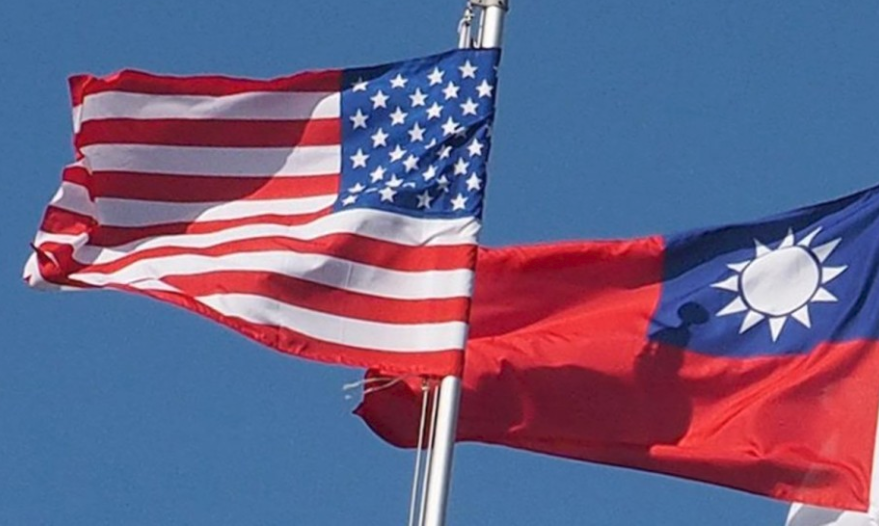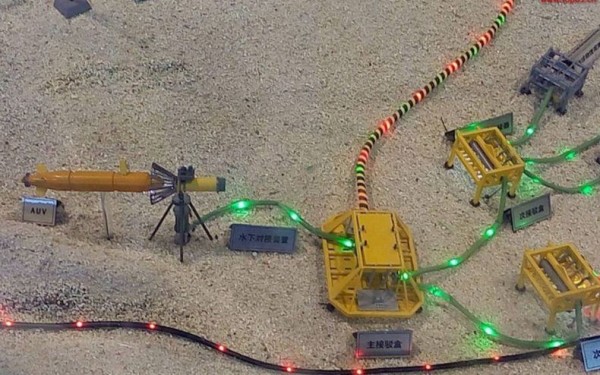China’s ‘Underwater Great Wall’ Defense Line in South China Sea Begins to Take Shape
| Arthur Dominic Villasanta | | Oct 13, 2016 10:07 PM EDT |
(Photo : PLAN) Desktop model of part of China's Underwater Great Wall in the South China Sea.
China has begun implementing Phase Three of its undersea defense system in the South China Sea called the "Underwater Great Wall" by deploying underwater sensors as part of an international marine survey program.
China has deployed its first eight made in China floating sensors in the South China Sea as part of "Argo," a collaborative partnership of over 30 nations to provide a seamless global array allowing any country to explore the ocean environment.
Like Us on Facebook
Argo is a system for observing temperature, salinity and currents in the Earth's oceans and has been operational since the early 2000s. The real-time data it provides is used in climate and oceanographic research.
Some military analysts say China's participation in Argo is intended to enhance its scientific knowledge about the disputed waters, especially what's beneath the surface, since the Chinese sensors have both civilian and military uses.
China plans to have 20 operational sensors about a meter beneath the surface of the South China Sea. China's sensors can monitor the submarine environment up to a depth of two kilometers.
Data from the sensors is transmitted to the mainland using China's BeiDou Satellite Navigational System that also has numerous military uses. China's decision to use BeiDou and not the U.S. GPS to transmit data from its sensors also has military significance.
This August, Vice-Premier Zhang Gaoli approved the plan replacing all imported sensors with ones made in China and supported by BeiDou. Chinese scientists are also developing technologies to probe undersea depths down to six kilometers.
Military analyst Antony Wong Dong said these sensors could benefit the People's Liberation Army Navy (PLAN) indirectly since its submarines demand a large amount of real time data about water temperatures, pressure and currents, among others.
"The South China Sea is very big and China still has a lot of blind spots," said Wong. "The sea environment changes fast. It will be really dangerous to deploy submersibles if they don't monitor the waters closely."
Taken together, these new developments seem to confirm suspicions China has triggered Phase Three of its plan to build an Underwater Great Wall in the South China Sea.
A news story in this website last June exposed the existence of this Underwater Great Wall. It said this wall will consist of sensors, robot undersea vehicles, torpedoes and a manned "deep-sea space station" to further solidify Beijing's control over this hotly disputed area.
The Underwater Great Wall Project will be disguised as a scientific "natural resource development project" requiring an undersea base and a fleet of drone submarines, according to sources.
Analysts said this allegedly civilian project will form the basis for a future underwater military defense system designed to cement Chinese hegemony over the South China Sea while keeping the U.S. Navy at bay.
This underwater defense line will complete China's triad of control over the South China Sea. The first leg of this triad are the military outposts on reclaimed islands defended by HQ-9 surface-to-air missiles (SAM) and supersonic jet fighters such as the Shenyang J-11, a long range air superiority fighter.
The second leg will be an ADIZ or Air Defense Identification Zone that will effectively bar military and civilian aircraft from outside China entering the airspace above the South China Sea without China's permission.
The Underwater Great Wall, the third leg, is meant to counter the U.S. Navy's fleet of attack and ballistic missile submarines against which PLAN has no credible defense. Anti-submarine warfare is the greatest tactical weakness of the PLAN.
Also arousing suspicion is the proposed location of this "natural resources project." Its deep- sea space station will be built at a depth of 3,000 meters below the surface and will be manned by a full-time crew. No country has ever attempted to build a manned underwater base at these crushing depths.
Analysts said this underwater station might anchor the Underwater Great Wall.
"But we can't rule out it will carry some military functions," said Xu Liping, a senior researcher of Southeast Asia affairs at the Chinese Academy of Social Sciences.
Tagschina, Underwater Great Wall, South China Sea, Argo, BeiDou Satellite Navigational System, Zhang Gaoli
©2015 Chinatopix All rights reserved. Do not reproduce without permission
 Drones are the Future of Undersea Warfare in the US Navy
Drones are the Future of Undersea Warfare in the US Navy Destroying China’s Militarized Islands will take about 15 Minutes, says Former US Spy Chief
Destroying China’s Militarized Islands will take about 15 Minutes, says Former US Spy Chief Xi Jinping Reveals ‘USA Killer’ DF-41 ICBM will Become Operational Very Soon
Xi Jinping Reveals ‘USA Killer’ DF-41 ICBM will Become Operational Very Soon Chinese Aerial Drones to Map South China Sea; Might Snoop on Vietnam’s Rebuilt Islands
Chinese Aerial Drones to Map South China Sea; Might Snoop on Vietnam’s Rebuilt Islands
EDITOR'S PICKS
-

Did the Trump administration just announce plans for a trade war with ‘hostile’ China and Russia?
-

US Senate passes Taiwan travel bill slammed by China
-

As Yan Sihong’s family grieves, here are other Chinese students who went missing abroad. Some have never been found
-

Beijing blasts Western critics who ‘smear China’ with the term sharp power
-

China Envoy Seeks to Defuse Tensions With U.S. as a Trade War Brews
-

Singapore's Deputy PM Provides Bitcoin Vote of Confidence Amid China's Blanket Bans
-

China warns investors over risks in overseas virtual currency trading
-

Chinese government most trustworthy: survey
-

Kashima Antlers On Course For Back-To-Back Titles
MOST POPULAR
LATEST NEWS
Zhou Yongkang: China's Former Security Chief Sentenced to Life in Prison

China's former Chief of the Ministry of Public Security, Zhou Yongkang, has been given a life sentence after he was found guilty of abusing his office, bribery and deliberately ... Full Article
TRENDING STORY

China Pork Prices Expected to Stabilize As The Supplies Recover

Elephone P9000 Smartphone is now on Sale on Amazon India

There's a Big Chance Cliffhangers Won't Still Be Resolved When Grey's Anatomy Season 13 Returns

Supreme Court Ruled on Samsung vs Apple Dispute for Patent Infringement

Microsoft Surface Pro 5 Rumors and Release Date: What is the Latest?










